2. 东北石油大学,大庆 163318;
3. 海相储层演化与油气富集机理教育部重点实验室,中国地质大学,北京 100083;
4. 页岩气勘查与评价国土资源部重点实验室,中国地质大学,北京 100083
2. Northeast Petroleum University, Daqing 163318, China;
3. Key Laboratory for Marine Reservoir Evolution and Hydrocarbon Abundance Mechanism, Ministry of Education, China University of Geosciences,Beijing 100083,China;
4. Key Laboratory for Shale Gas Exploitation and Assessment, Ministry of Land and Resources, China University of Geosciences,Beijing 100083,China
近年来,美国的海相页岩气勘探开发的巨大成功表明(Warlick,2006;Hill and Nelson, 2000;聂海宽等, 2009a, b ;李新景等, 2007, 2009;谭蓉蓉,2009;Montgomery et al., 2005;Bowker,2007),富含有机质的页岩层系在一定的地质条件下,如果天然裂缝发育或经过人工压裂改造后能够产生大量裂缝系统时,其完全可以成为页岩气聚集的有效储集层(Curtis,2002;Hill and Lombardi, 2002;Nelson,1985;Zhu et al., 2013a;孙岩等,2008;曾联波和肖淑蓉,1999;丁文龙等,2011a)。因此,对富有机质页岩层系的特征与分布、页岩气形成条件和成藏机理及富集规律等方面的研究(Ding et al., 2011, 2012, 2013a, b ;Zhu et al., 2013b;陈尚斌等, 2010, 2011;丁文龙等, 2011a, b , 2012;张金川等,2004;李天义等,2008;陈更生等,2009;聂海宽和张金川,2010;秦建中等, 2010;张林晔等,2009;李登华等,2009;张利萍和潘仁芳,2009;龙鹏宇等,2011),目前受到了国内外广泛重视,各国相继开展了不同程度的页岩气资源调查评价与钻探及开发工作,现已取得了比较丰富的地质认识和页岩气勘探成果。我国页岩气勘探正处在快速起步阶段,特别是南方上扬子地区广泛分布的下古生界海相富有机质页岩层系厚度大、有机质类型好、丰度高、热成熟度高、脆性矿物含量高、裂缝发育等,是我国海相页岩气勘探的有利地区(金之钧和蔡立国,2006;吕炳全等,2004;杨剑等,2004;张水昌等,2005;袁宏等,2007;张宝民等,2007;张伦尉等;2007;王清晨和林伟,2008;冯常茂等,2008;梁狄刚等, 2008, 2009;程克明等,2009;李双建等,2008;王兰生等,2009;王社教等,2009;刘文汇等,2010;蒲泊伶等, 2010;李建忠等,2012;李娟等,2012;聂海宽等, 2009a, b ,2011, 2012;久凯等, 2012a, b ;董大忠等, 2010, 2012;Zeng et al., 2013a, b ; Zhu et al., 2013c),其中,位于上扬子地台(板块)上的黔北地区是我国页岩气资源战略调查的先导实验区之一(图 1)。区内下寒武统牛蹄塘组(
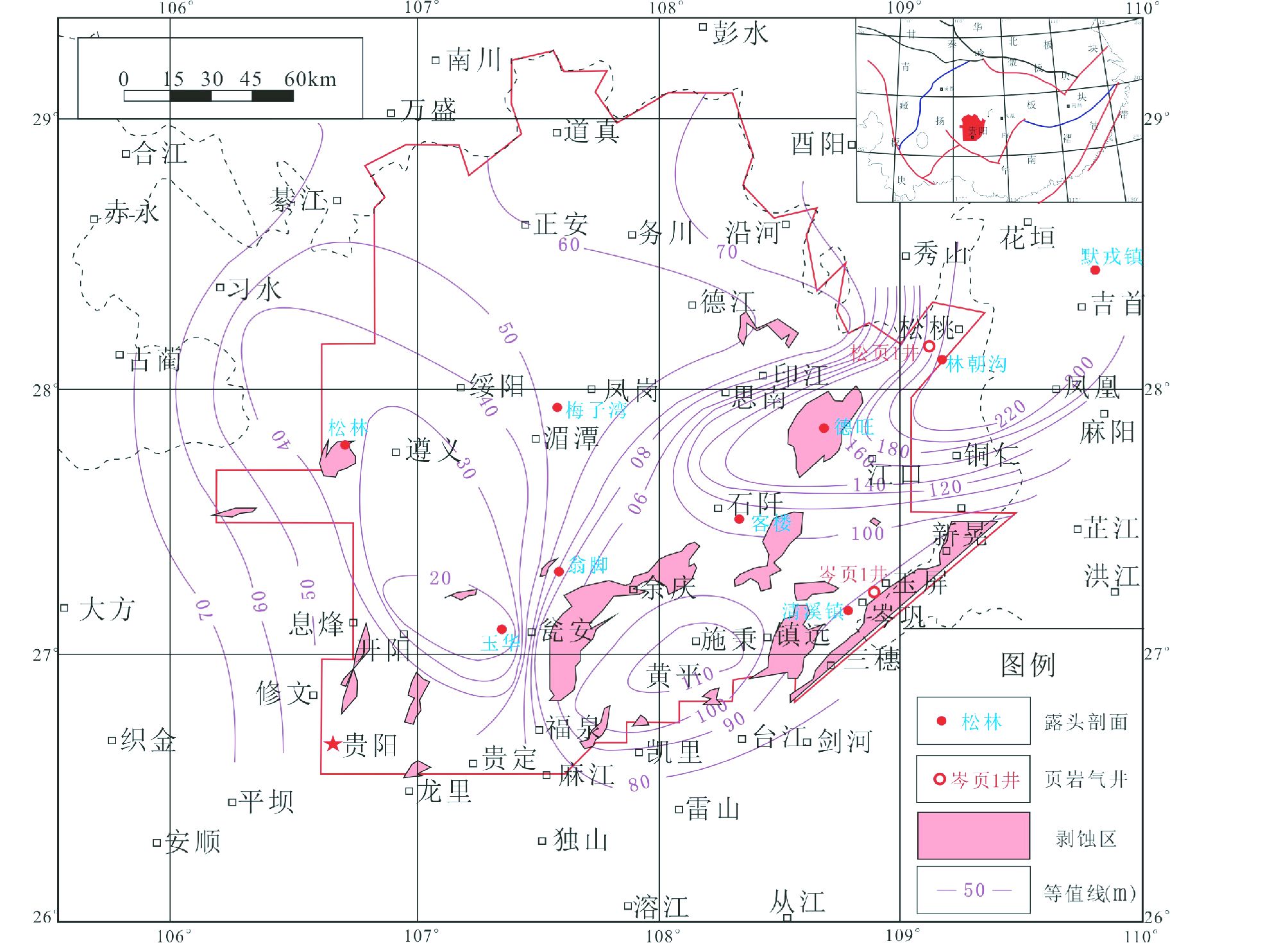
|
图 1 黔北地区下寒武统牛蹄塘组黑色页岩剖面位置及厚度分布图 Fig. 1 Outcrop section location and thickness map of Lower Cambrian(Niutitang Formation)black shale in Qianbei area |
根据黔北地区10多条下寒武统牛蹄塘组野外露头剖面地质调查和实际测量及2口页岩气钻井,结合区域构造和沉积地层分布特征(贵州省地质局,1987;滇黔桂石油地质编写组,1992;马力等,2004;陈洪德等,2004;梅冥相和徐德斌,1996;马永生等,2009),确定了下寒武统牛蹄塘组黑色页岩层系的厚度及分布,其分布广泛,厚度在20~220m之间,黔北地区东南部厚度大,大于80m,呈北东-南西向展布,厚度最大的地区位于松桃-江口-铜仁地区,厚度在100~200m之间,其次是黄平-施秉地区,厚度为90~110m(图 1)。
2.2 沉积环境依据研究区内10多条下寒武统牛蹄塘组野外实测剖面的层序与沉积相分析结果,将牛蹄塘组地层划分为1个三级层序,包括海侵体系域(TST)和高位体系域(HST)(图 2)。海侵体系域可进一步划分为两个退积准层序组,发育黑色泥页岩和黑色粉砂质泥页岩,为浅海深水陆棚相沉积。海侵体系域后期,伴随着相对海平面的下降,形成了一套向上变粗的高位体系域沉积体,底部以黑色泥页岩为主,往上逐渐变化为深灰色泥页岩,同时粉砂岩和泥质粉砂岩含量逐渐增多,颜色变浅,在剖面上可以看到明显的进积序列,反映出了水体深度逐渐变浅的过程,即海平面的相对下降。高位体系域又可细分为两个准层序组,准层序组1主要为深灰色泥页岩和深灰色粉砂质泥页岩,向上粉砂质含量相对增多,为浅海浅水陆棚沉积;准层序组2主要为深灰色泥质粉砂岩,深灰色粉砂质泥页岩和灰色粉砂质泥页岩,为浅海砂质陆棚沉积。研究区内下寒武统牛蹄塘组沉积相剖面对比研究,比较好地反映了层序格架内不同体系域沉积相横向变化特征(图 3、图 4),为沉积相平面分布提供了重要依据。

|
图 2 黔北地区瓮安县永和剖面下寒武统牛蹄塘组沉积相分析图 Fig. 2 Sedimentary analysis map of Lower Cambrian(Niutitang Formation)black shale in Yonghe section, Wengan County, Qianbei area |

|
图 3 松林-梅子湾-客楼镇-镇远清溪镇下寒武统牛蹄塘组沉积相剖面对比图 Fig. 3 Sedimentary facies comparison map of Lower Cambrian(Niutitang Formation)black shale in Songlin-Meiziwan-Kelou Town-Zhenyuanqingxi Town |
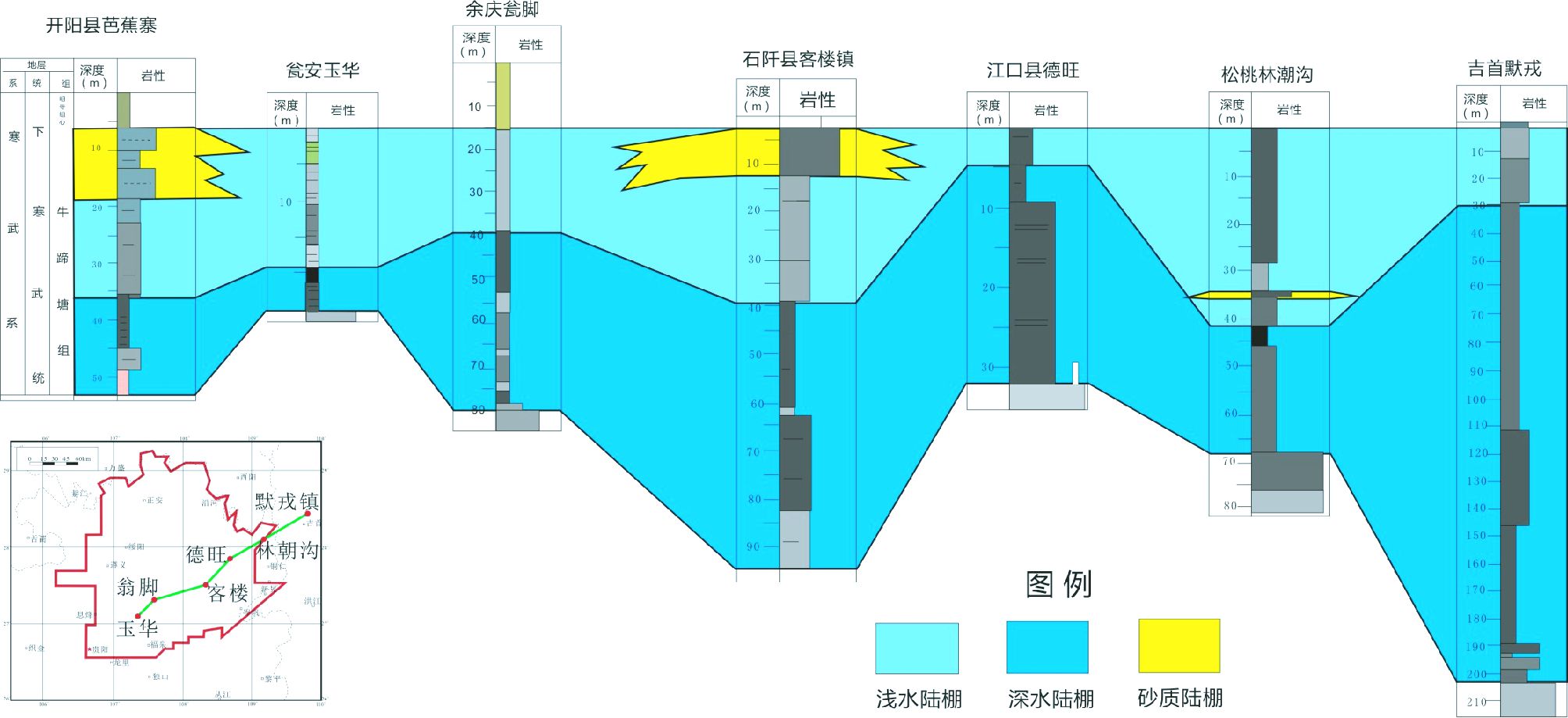
|
图 4 芭蕉寨-玉华-翁脚-客楼镇-德旺-林潮沟-默戎下寒武统牛蹄塘组沉积相剖面对比图 Fig. 4 Sedimentary facies comparison map of Lower Cambrian(Niutitang Formation)black shale in Bajiaozhai-Yuhua-Wengjiao- Kelou Town-Dewang-Linchaogou-Morong |
通过对研究区内下寒武统牛蹄塘组页岩剖面中的各个体系域的地层厚度、黑色泥页岩厚度、灰色粉砂质泥页岩和灰色泥质粉砂岩厚度的统计,结合各种相标志、岩石相特征、单剖面相和沉积相剖面对比分析等,确定了牛蹄塘组两个体系域的沉积相类型与分布(图 5a, b),分析了不同体系域沉积相的展布特征。
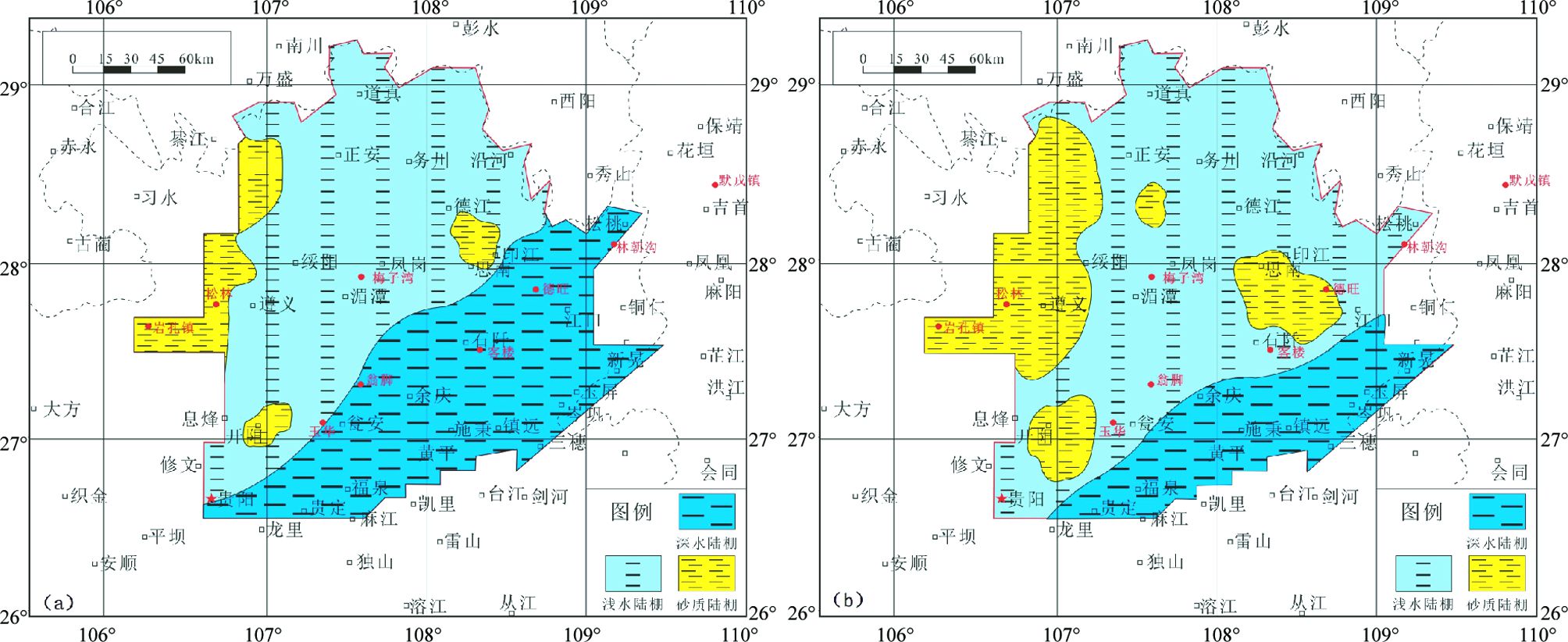
|
图 5 黔北地区下寒武统牛蹄塘组TST(a)和HST(b)沉积相平面分布图 Fig. 5 TST(a) and HST(b)sedimentary facies distribution map of Lower Cambrian(Niutitang Formation)black shale in Qianbei region |
海侵体系域(TST)沉积相 黔北地区下寒武统牛蹄塘组海侵体系域沉积时期,水体相对较深,主要发育黑色泥页岩和少量灰色泥页岩和粉砂岩,沉积相类型主要为砂质陆棚、浅水陆棚和深水陆棚相沉积。砂质陆棚主要出现在黔北地区西部偏北方向;浅水陆棚发育在西北部广大地区;深水陆棚分布在东南部地区,呈北西-南东向宽带状展布。岩石类型主要为黑色泥页岩,在区内西南部和西北部还发育有少量粉砂质泥页岩;沉积和沉降中心位于研究区的东南部,主要的物源来自西北部(图 5a)。
高位体系域(HST)沉积相 随着相对海平面的下降,水体深度逐渐变浅,研究区陆棚砂体范围进一步扩大,浅水陆棚和深水陆棚向东南迁移,范围缩小;由西北向东南方向依次为砂质陆棚、浅水陆棚和深水陆棚相沉积。砂质陆棚主要出现在西部;浅水陆棚在区内大范围分布;深水陆棚仍位于黔北地区的东南部,呈北东-南西向窄条带状分布,为高位体系域沉积时期的沉积中心区域(图 5b)。
3 泥页岩有机地球化学特征 3.1 有机质丰度有机质丰度是衡量黑色富有机质泥页岩生气质量好坏的重要地球化学指标。主要包括有机碳含量(TOC)和氯仿沥青“A”等,由于我国海相地层发育时代早、经历的构造运动的期次多,残留氯仿沥青“A”含量普遍很低,不能准确反映我国海相页岩的生气能力,故本次研究主要采用有机碳含量(TOC)对海相黑色页岩生气质量进行了评价。
根据黔北地区35个下寒武统牛蹄塘组页岩露头剖点、松页1井和岑页1井岩心大量样品有机地球化学实验分析结果表明(表 1、图 6),黑色页岩的有机碳含量(TOC)在0.4%~14.30%之间,平均值为4.88%,有机碳含量普遍大于2%,表明下寒武统黑色页岩的有机碳含量很高,是一套重要的富有机质页岩层系。需要说明的是本次实验分析主要是露头泥页岩样品,因受不同程度的氧化作用而导致有机碳含量降低,因此,在露头采样点的地下深层或钻井岩心页岩样品的有机碳含量要比实验测得的还要大一些。在平面上,黔北地区下寒武统牛蹄塘组高有机碳含量主要分布于深水陆棚相和浅水陆棚相,分布广泛,平均值高达4%以上(图 7)。
|
|
表 1 黔北地区下寒武统牛蹄塘组黑色泥页岩剖面有机碳含量(TOC)和成熟度(Ro)实验数据 Table 1 Organic carbon content(TOC) and maturity(Ro)experimental data of Lower Cambrian(Niutitang Formation)black shale in Qianbei region |
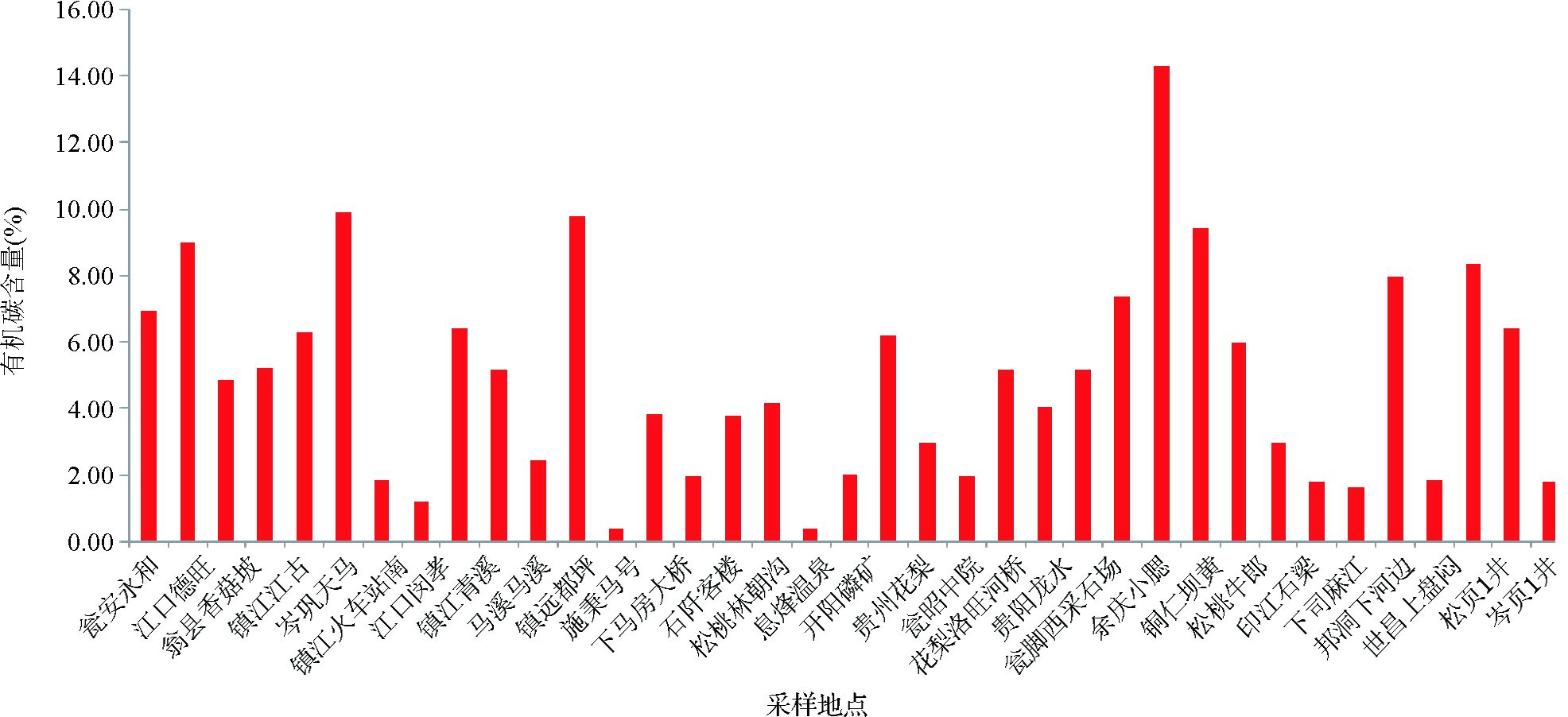
|
图 6 黔北地区下寒武统牛蹄塘组黑色泥页岩主要样品点有机碳含量直方图 Fig. 6 Histogram of main samples’ organic carbon content of Lower Cambrian(Niutitang Formation)black shale in Qianbei region |

|
图 7 黔北地区下寒武统牛蹄塘组黑色泥页岩有机碳含量(%)等值线图 Fig. 7 Organic carbon content(%)contour map of Lower Cambrian(Niutitang Formation)black shale in Qianbei region |
黔北地区下寒武统牛蹄塘组黑色页岩的成熟度(Ro)在1.35%~4.20%之间,平均值为2.70%(表 1、图 8),该套黑色页岩层总体演化程度较高,全区未见成熟度小于1.0%的区域,这些值对页岩气资源早期调查评价和有利区优选、浅井钻探选择均具有重要的参考价值。在平面上,除了贵州瓮安永和、施秉马号、开阳磷矿、花梨落旺河桥等采样点泥页岩有机质成熟度低于2%外,其余地区普遍等于或大于2.2%,特别是松桃、石阡、岑巩-玉屏附近有机质成熟度高达3%以上,形成了高值区(图 9)。根据美国页岩气勘探经验实践,同样具有页岩气潜力,美国页岩气产区的页岩成熟度普遍大于1.3%,在阿巴拉起亚盆地的西弗吉尼亚州南部最高可达4.0%,且只有在成熟度较高的区域才有页岩气的产出,因此,页岩的高成熟度(>2%)不是制约页岩气聚集的主要因素,相反,成熟度越高越有利于页岩气的生产,说明在高成熟度下也能有页岩气的聚集。

|
图 8 黔北地区下寒武统牛蹄塘组黑色泥页岩主要样品点成熟度直方图 Fig. 8 Histogram of main samples’ maturity of Lower Cambrian(Niutitang Formation)black shale in Qianbei region |
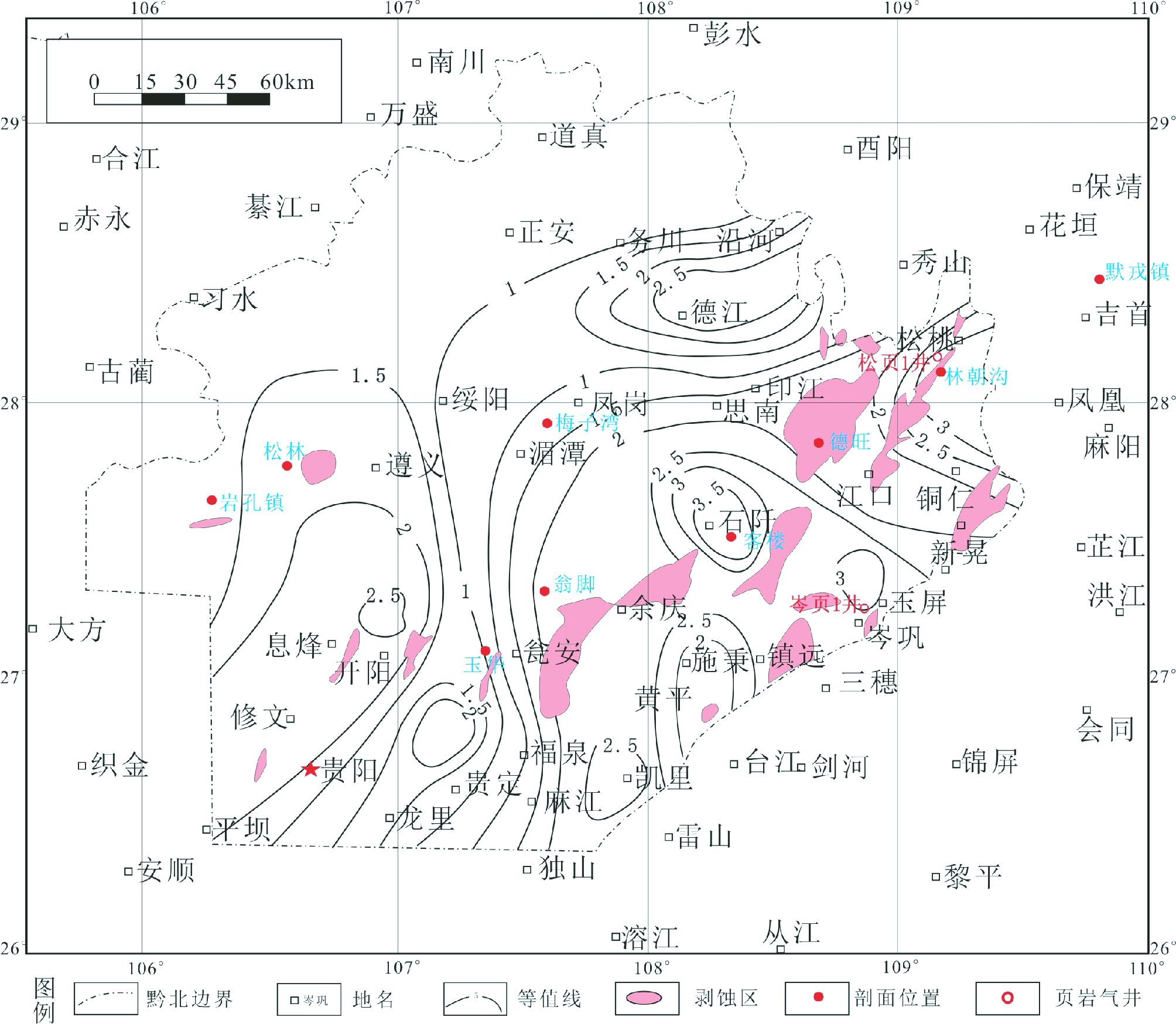
|
图 9 黔北地区下寒武统牛蹄塘组黑色泥页岩有机质成熟度分布图 Fig. 9 Organic material maturity distribution map of Lower Cambrian(Niutitang Formation)black shale in Qianbei region |
有机质类型也是评价富有机质页岩生气质量的重要指标之一,它对页岩的生气潜力和性质起着决定性的作用,因此,本次根据黔北地区松页1井和岑页1井下寒武统牛蹄塘组13个黑色页岩样品的显微组分分析和荧光特性,研究认为黔北地区下寒武统牛蹄塘组黑色页岩中的有机质颗粒有多种形态,如不规则细粒状、长条状和尘点状,有时有机质颗粒中可见许多极小的黄铁矿散布。干酪根显微组分主要腐泥组为主,包括腐泥无定型和碎屑体,其总百分含量高,在68%以上,平均值为80%;其次为镜质组(沥青),包括结构镜质体和无结构镜质体,二者总的百分含量值在12%~30%之间,平均值是19.9%;缺乏惰质组和壳质组。
干酪根镜检类型指数(TI值)在47~78.5之间,平均值为65.15,属于Ⅱ1型干酪根(表 2)。显微组分以块状、脉状、条状、碎屑状沥青为主,油浸反射光下呈灰色-灰白色,不发荧光(图 10a, b)。
|
|
表 2 黔北地区松页1井、岑页1井下寒武统牛蹄塘组黑色泥页岩干酪根显微组分鉴定数据 Table 2 Songye 1 Well and Cenye 1 Well’s micro-components data of Lower Cambrian(Niutitang Formation)black shale in Qianbei region |

|
图 10 黔北地区下寒武统牛蹄塘组黑色泥页岩微观组分荧光照片 (a)-灰白色块状沥青(贵州省镇远县青溪镇鸡鸣村下寒武统;(b)-灰色沥青(贵州省施秉县马号乡,下寒武统黑色碳质页岩)黑色碳质页岩) Fig. 10 Micro-components micrograph of Lower Cambrian(Niutitang Formation)black shale in Qianbei region |
根据黔北地区19个下寒武统牛蹄塘组黑色泥页岩露头剖面、松页1井、岑页1井96页岩岩心样品的全岩和粘土矿物定量分析(X射线衍射)和扫描电镜观察结果,下寒武统牛蹄塘组黑色泥页岩的矿物成分主要为碎屑矿物和粘土矿物,还有少量的碳酸盐岩、黄铁矿和重晶石。其中碎屑矿物含量在28%~87%之间,平均值为61.3%,成分主要为石英和少量的长石,粘土矿物含量在8%~47%之间,平均值为31.1%,主要为伊利石和伊蒙混层矿物,以及少量的高岭石和绿泥石。其中,伊利石含量在26%~91%之间,平均值为59.6%;伊蒙混层矿物在5%~63%之间,平均值为26.5%。伊蒙混层矿物中蒙脱石平均占到了19.5%(图 11、图 12)。

|
图 11 黔北地区下寒武统牛蹄塘组黑色泥页岩矿物组成及百分含量图 Fig. 11 Mineral composition and percentage content map of Lower Cambrian(Niutitang Formation)black shale in Qianbei region |
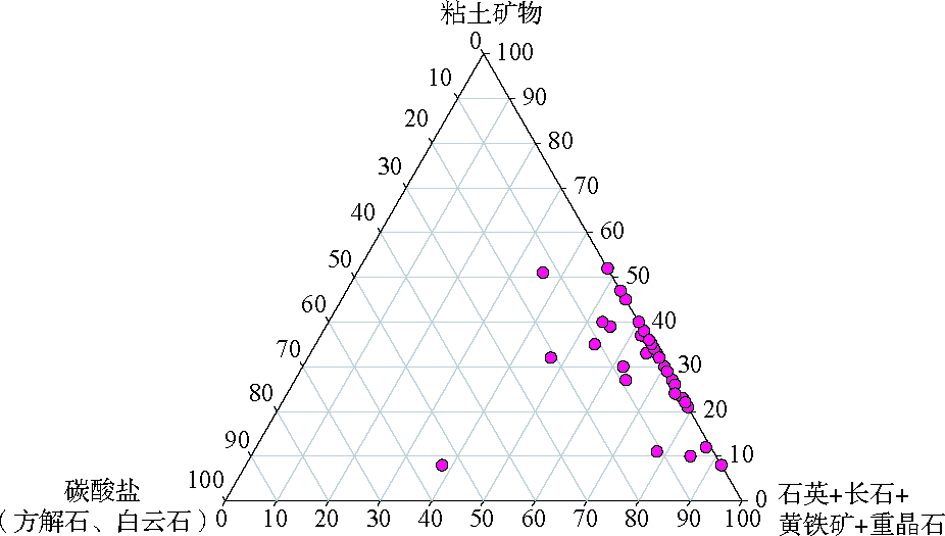
|
图 12 黔北地区下寒武统牛蹄塘组黑色页岩矿物组成及百分含量三角图 Fig. 12 Mineral composition and percentage content triangular map of Lower Cambrian(Niutitang Formation)black shale in Qianbei region |
黔北地区松页1井和岑页1井牛蹄塘组页岩岩心全岩和粘土矿物定量分析结果亦证实了露头样品的分析认识,2口井页岩中石英和长石矿物的总含量分别是53.17%和43.62%,方解石和白云石矿物的总含量为10.62%和7.55%,粘土矿物总量是24.3%和43.32%(表 3)。粘土矿物中以伊利石和伊蒙混层为主,伊利石含量分别是55.53%和63.57%,伊蒙混层含量是35.84%和22.64%;高岭石和绿泥石含量较低(表 4)。从粘土矿物成分和有机质成熟度来看,本区泥页岩也已到了晚成岩作用C阶段。由此可见,黔北地区下寒武统牛蹄塘组石英和粘土矿物的含量为黑色泥页岩的主要组成部分,它对页岩吸附气含量会有很大的影响。
|
|
表 3 黔北地区松页1井、岑页1井下寒武统牛蹄塘组黑色泥页岩全岩定量分析数据 Table 3 Songye 1 Well and Cenye 1 Well’s rock components analysis data of Lower Cambrian(Niutitang Formation)black shale in Qianbei region |
|
|
表 4 黔北地区松页1井、岑页1井下寒武统牛蹄塘组黑色泥页岩粘土矿物定量分析数据 Table 4 Songye 1 Well and Cenye 1 Well’s clay minerals analysis data of Lower Cambrian(Niutitang Formation)black shale in Qianbei region |
在系统分析了黔北地区下寒武统牛蹄塘组黑色泥页岩形成的沉积相与厚度分布、有机地球化学特征和岩性与矿物组成的基础上,与美国主要产气页岩的特征对比,结合我国页岩气选区标准,初步评价预测了黔北地区下寒武统页岩气勘探潜力与远景区。
5.1 与美国主要盆地产气页岩特征比较根据北美已投入开发的页岩气藏统计表明,商业性开采的页岩气储层具有以下主要特征:页岩厚度大(大于30m);分布范围广、有机质丰度高,有机碳含量(TOC)大于2%;成熟度(Ro)为1.1%~2.5%,处于成熟-高成熟-过成熟阶段;脆性矿物含量高,范围为40%~60%,平均值在50%左右;粘土矿物含量中等,为25%~30%,小于40%, 埋藏深度适中,一般小于3000m;页岩孔隙度为3%~10%。
黔北地区下寒武统海相黑色页岩与美国主要盆地产气页岩特征对比可以看出(表 5、表 6)。(1) 黔北地区下寒武统牛蹄塘组海相黑色页岩累计厚度为30~220m,其略小于美国产页岩气页岩的厚度31~305m;(2) 黔北地区下寒武统黑色页岩有机碳含量(TOC)范围值总体低于美国页岩气藏页岩,但其平均值高,黔北地区下寒武统黑色页岩有机碳含量(TOC)范围值为0.4%~14.3%,平均值为4.88%,而美国高 产商业性开采的页岩气储层有机碳含量(TOC)范围值在0.30%~25.0%,平均值一般大于2.0%,最好的页岩在2.5~3.0%以上。(3) 黔北地区下寒武统黑色泥页岩有机质类型与美国黑色页岩的有机质类型相同,二者均为Ⅱ型干酪根。(4) 黔北地区下寒武统黑色页岩热成熟度明显比美国产气页岩的成熟度高,其镜质体反射率Ro%值在1.35%~4.2%之间,平均值为2.7%,处于高成熟-过成熟热解气阶段,而美国产气的页岩成熟度Ro%平均值范围为0.4%~1.30%,处在低成熟生物气和成熟热解气阶段。(5) 在岩石矿物组成及百分含量方面,黔北地区下寒武统黑色泥页岩的脆性矿物组成与美国产页岩气页岩比较,脆性矿物总含量范围值为28%~87%,平均值为61.3%,低于美国的产气页岩脆性矿物总含量,其平均值范围在70%~75%。在粘土矿物含量方面,黔北地区下寒武统黑色页岩粘土矿物含量与美国产气页岩的含量相当,其平均值为31.1%,而美国页岩粘土矿物含量平均值范围是25%~30%,小于40%。(6) 黔北地区下寒武统黑色页岩孔隙度值亦与美国页岩孔隙度值接近,小于10%。
|
|
表 5 黔北地区下寒武统海相黑色页岩与美国主要盆地产气页岩有机地球化学特征参数对比表 Table 5 Comparison of organic geochemistry data between Lower Cambrian marine black shale in China’s Qianbei region and major shale gas basins in American |
|
|
表 6 黔北地区下寒武统海相黑色页岩与美国古生界海相产气页岩储层特征比较表 Table 6 Comparison of shale reservoir characteristics between Lower Cambrian marine black shale in China’s Qianbei region and marine shale in American |
综上所述,与美国产气页岩的各项指标相比较,黔北地区下寒武统海相黑色页岩具有厚度较大、有机质丰度平均值高、热演化熟度高、脆性矿物含量低、粘土矿物含量中等,页岩孔隙度低的特征。黔北地区下寒武统海相黑色页岩具备了页岩气形成的基本地质条件,发育有页岩气勘探的远景地区,是我国海相页岩气勘探的主要地区之一。
5.2 页岩气远景区评价预测根据国土资源部油气资源战略研究中心与中国地质大学(北京)2011年8月制定的《页岩气资源潜力评价与有利区优选方法》方案,结合我国油气勘探现状及页岩气资源特点,将页岩气分布区划分为远景区、有利区和目标区(核心区)等三级。其中页岩气远景区是指在区域地质调查基础上,结合地质、地球化学、地球物理等资料,优选出的具备规模性页岩气形成地质条件的潜力区域。远景区优选基础是以区域地质资料为基础,了解区域构造、沉积及地层发育背景,查明含有机质泥页岩发育的区域地质条件,初步分析页岩气的形成条件,对评价区进行以定性-半定量为主的早期评价。海相页岩气远景区优选主要参考指标如表 7所示。
|
|
表 7 海相页岩气远景区优选评价指标 Table 7 Preferred evaluation index in marine shale gas prospective area |
依据上述海相页岩气远景区的选区基础和优选参考指标,结合黔北地区目前是以野外页岩气地质调查为主的低勘探程度现状,在分析了黔北地区下寒武统海相黑色页岩的特征及其分布规律,并与美国主要产页岩气盆地内页岩有机地球化学指标和储层特征参数对比基础上,选取了页岩形成的沉积相、厚度、有机质丰度、类型、成熟度、埋深等指标,参考地表和保存条件等,综合评价预测了黔北地区下寒武统牛蹄塘组页岩气的有利、较有利和不利远景区(图 13)。
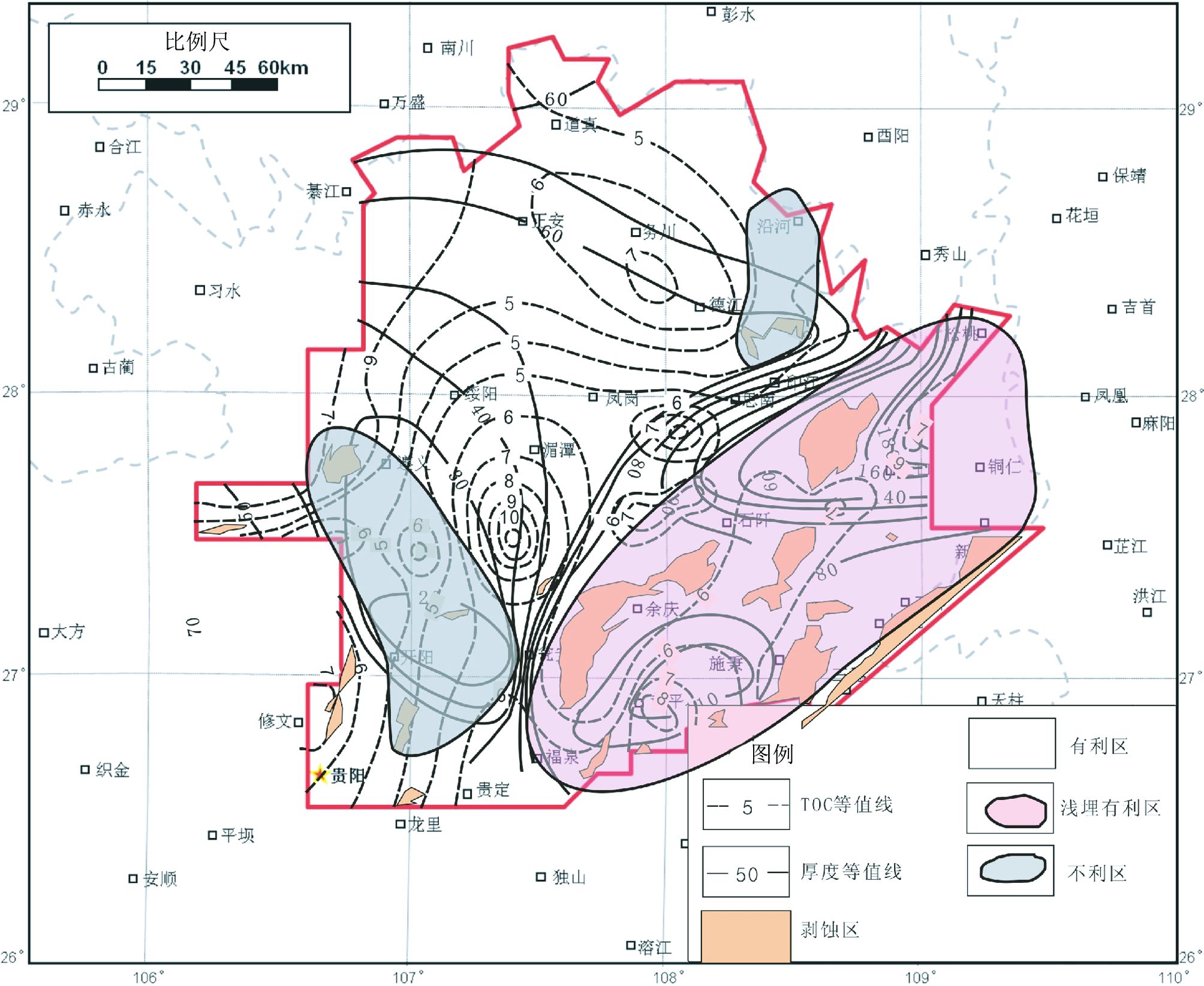
|
图 13 黔北地区下寒武统牛蹄塘组页岩气远景区评价预测图 Fig. 13 Prospective area prediction map of Lower Cambrian(Niutitang Formation)black shale in Qianbei region |
评价结果将下寒武统页岩气远景区划分为三级:(1) 有利远景区:江口、思南、正安、务川和道真一带的TOC值高,Ro值中等,富有机质页岩厚度在50~70m左右,比较厚,埋深多大于1000m,部分埋深达到了4000m,有利于页岩气保存,为黔北地区下寒武页岩气有利远景区,适合后期大规模、成体系的开发。(2) 较有利远景区:瓮安、余庆、石阡、岑巩和松桃一带由于构造抬升作用导致了该地区下寒武统黑色页岩页岩层系埋深比较浅,一般小于2500m,有机碳含量TOC值较高,Ro值中等,厚度在80~120m,局部区域达到了220m,对页岩气聚集较为有利。(3) 不利远景区:遵义、开阳、瓮安西部地区和沿河一带,虽然有机碳含量TOC值亦比较高,但黑色泥页岩厚度比较小,小于30m,对页岩气聚集较为不利。
6 结论(1) 黔北地区下寒武统牛蹄塘组可以划分为1个三级层序,包括海侵体系域和高位体系域,早期海侵体系域水体相对较深,主要发育黑色泥页岩和少量灰色泥页岩和粉砂岩,沉积沉降中心位于研究区的东南部,主要的物源来自西北部,沉积相类型主要为砂质陆棚、浅水陆棚和深水陆棚相沉积,深水陆棚相分布在东南部地区,呈北西-南东向带状展布。晚期高位体系域,水体深度逐渐降低,随着相对海平面的下降,研究区陆棚砂体范围进一步扩大,浅水陆棚和深水陆棚向东南迁移,范围缩小。
(2) 大量页岩样品有机地球化学实验分析结果表明,黔北地区下寒武统牛蹄塘组黑色页岩的有机质类型为Ⅱ1型干酪根,显微组分主要表现为腐泥组、其次为镜质组(沥青),缺乏惰质组和壳质组;有机碳含量很高,平均值为4.88%,普遍大于2%;有机质成熟度平均值为2.7%,热演化程度较高,依据美国页岩气勘探实践,其同样具有页岩气资源潜力,页岩的高成熟度(>2%)不是制约页岩气聚集的主要因素,相反,成熟度越高越有利于页岩气的生产,说明在高成熟度下也能有页岩气的聚集。
(3) 黔北地区下寒武统牛蹄塘组黑色页岩的矿物成分主要为碎屑矿物和粘土矿物,还有少量的碳酸盐岩、黄铁矿和重晶石。其中碎屑矿物含量平均值为61.3%,成分主要为石英和少量的长石;粘土矿物含量平均值为31.1%,主要为伊利石和伊蒙混层矿物,以及少量的高岭石和绿泥石。
(4) 与美国产气页岩的各项指标相比较,黔北地区下寒武统海相黑色页岩具有厚度较大、有机质丰度平均值高、热演化熟度高、脆性矿物含量低、粘土矿物含量中等,页岩孔隙度低的特征。黔北地区下寒武统海相黑色页岩具备了页岩气形成的基本地质条件,发育有页岩气勘探的远景地区,是我国海相页岩气勘探的主要地区之一。
(5) 依据黔北地区下寒武统海相黑色页岩的特征与其分布规律,并与美国主要产页岩气盆地内页岩有机地球化学指标和储层特征参数对比,选取了页岩形成的沉积相、厚度、有机丰度、类型、成熟度、埋深等指标,参考地表和保存条件等,综合评价预测了黔北地区下寒武统牛蹄塘组页岩气的有利、较有利远景区。
| [] | Bowker KA. 2007. Barnett shale gas production, Fort Worth Basin: Issues and discussion. AAPG Bulletin, 91(4): 523–533. DOI:10.1306/06190606018 |
| [] | Bureau of Geology of Guizhou Province. 1987. Regional Geology of Guizhou Province. Beijing: Geological Publishing House: 554-632. |
| [] | Chen GS, Dong DZ, Wang SQ, et al. 2009. A preliminary study on accumulation mechanism and enrichment pattern of shale gas. Natural Gas Industry, 29(5): 17–21. |
| [] | Chen HD, Qin JX, Tian JC. 2004. Types and features of source-reservoir-cap rock combinations in Paleozoic sequence in southern China. Oil & Gas Geology, 25(1): 62–69. |
| [] | Chen L, Zhong H, Hu RZ, et al. 2006. Early Cambrian oceanic anoxic event in northern Guizhou: Biomarkers and organic carbon isotope. Acta Petrologica Sinica, 22(9): 2413–2423. |
| [] | Chen SB, Zhu YM, Wang HY, et al. 2010. Research status and trends of shale gas in China. Acta Petrolei Sinica, 31(4): 690–693. |
| [] | Chen SB, Zhu YM, Wang HY, et al. 2011. Characteristics and significance of mineral compositions of Lower Silurian Longmaxi Formation shale gas reservoir in the southern margin of Sichuan Basin. Acta Petrolei Sinica, 32(5): 775–782. |
| [] | Cheng KM, Wang SQ, Dong DZ, et al. 2009. Accumulation conditions of shale gas reservoirs in the Lower Cambrian Qiongzhusi Formation, the Upper Yangtze region. Natural Gas Industry, 29(5): 40–44. |
| [] | Curtis JB. 2002. Fractured shale-gas systems. AAPG Bulletin, 86(11): 1921–1938. |
| [] | Ding WL, Wan H, Su AG, et al. 2011. Characteristics of Triassic marine source rocks and prediction of favorable source kitchens in Qiangtang basin, Tibet. Energy, Exploration & Exploitation, 29(2): 143–160. |
| [] | Ding WL, Li C, Su AG, et al. 2011a. Study on the comprehensive geochemical cross section of Mesozoic marine source rocks and prediction of favorable hydrocarbon generation area in Qiangtan basin, Tibeta. Acta Petrologica Sinica, 27(3): 878–896. |
| [] | Ding WL, Xu CC, Jiu K, et al. 2011b. The research progress of shale fractures. Advances in Earth Science, 26(2): 135–144. |
| [] | Ding WL, Li C, Li CY, et al. 2012. Fracture development in shale and its relationship to gas accumulation. Geoscience Frontiers, 3(1): 97–105. DOI:10.1016/j.gsf.2011.10.001 |
| [] | Ding WL, Li C, Li CY, et al. 2012. Dominant factor of fracture development in shale and its relationship to gas accumulation. Earth Science Frontiers, 19(2): 212–220. |
| [] | Ding WL, Wan H, Zhang YQ, et al. 2013a. Characteristics of the Middle Jurassic marine source rocks and prediction of favorable source rock kitchens in the Qiangtang Basin of Tibet. Journal of Asian Earth Sciences, 66: 63–72. DOI:10.1016/j.jseaes.2012.12.025 |
| [] | Ding WL, Zhu DW, Cai JJ, et al. 2013b. Analysis of the developmental characteristics and major regulating factors of fractures in marine-continental transitional shale-gas reservoirs: A case study of the Carboniferous-Permian strata in the southeastern Ordos Basin, Central China. Marine and Petroleum Geology, 45: 121–133. DOI:10.1016/j.marpetgeo.2013.04.022 |
| [] | Dong DZ, Cheng KM, Wang YM, et al. 2010. Forming conditions and characteristics of shale gas in the Lower Paleozoic of the Upper Yangtze region, China. Oil and Gas Geology, 31(3): 288–299. |
| [] | Dong DZ, Zou CN, Yang H, et al. 2012. Progress and prospects of shale gas exploration and development in China. Acta Petrolei Sinica, 33(Suppl.1): 107–114. |
| [] | Feng CM, Liu J, Song LJ. 2008. Formation mechanism of the tectonic deformation belt and the prognosis of favorable oil and gas exploration areas in the Middle and Upper Yangtze Valley. Acta Geoscientia Sinica, 29(2): 199–204. |
| [] | Hill DG, Nelson CR. 2000. Reservoir properties of the Upper Cretaceous Lewis Shale, a new natural gas play in the San Juan Basin. AAPG Bulletin, 84(8): 1240. |
| [] | Hill DG, Lombardi TE. 2002. Fractured Gas Shale Potential in New York. Colorado: Arvada. |
| [] | Jin ZY, Cai LG. 2006. Exploration propects, problems and strategies of marine oil and gas in China. Oil and Gas Geology, 27(6): 723–730. |
| [] | Jiu K, Ding WL, Huang WH, et al. 2012a. Formation environment and controlling factors of organic-rich Shale of Lower Cambrian in Upper Yangtze Region. Geoscience, 26(3): 547–554. |
| [] | Jiu K, Ding WL, Li YX, et al. 2012b. Structural features in northern Guizhou area and reservoir fracture of Lower Cambrian shale gas. Natural Gas Geoscience, 23(4): 797–803. |
| [] | Li DH, Li JZ, Wang SJ, et al. 2009. Analysis of controls on gas shale reservoirs. Natural Gas Industry, 29(5): 22–26. |
| [] | Li J, Yu BS, Zhang JC, et al. 2012. Reservoir characteristics and their influence factors of the Lower Cambrian dark shale in northern Guizhou. Oil and Gas Geology, 33(3): 365–373. |
| [] | Li JZ, Zheng M, Zhang GS, et al. 2012. Potential and prospects of conventional and unconventional natural gas resource in China. Acta Petrolei Sinica, 33(Suppl.1): 89–98. |
| [] | Li SJ, Xiao KH, Wo YJ, et al. 2008. Developmental controlling factors of Upper Ordovician-Lower Silurian high quality source rocks in marine sequence, South China. Acta Sedimentologica Sinica, 26(5): 873–880. |
| [] | Li TY, He S, Yang Z. 2008. The marine source rock formation conditions and control factors. Geological Science and Technology Information, 27(6): 63–70. |
| [] | Li XJ, Hu SY, Cheng KM. 2007. Suggestions from the development of fractured shale gas in North America. Petroleum Exploration and Development, 34(4): 392–400. |
| [] | Li XJ, Lü ZG, Dong DZ, et al. 2009. Geological controls on accumulation of shale gas in North America. Natural Gas Industry, 29(5): 27–32. |
| [] | Liang DG, Guo TL, Chen JP, et al. 2008. Some progresses on studies of hydrocarbon generation and accumulation in marine sedimentary regions, southern China(Part one): Distribution of four suits of regional marine source rocks. Marine Origin Petroleum Geology, 13(2): 1–16. |
| [] | Liang DG, Guo TL, Bian LZ, et al. 2009. Controlling factors on the sedimentary facies and development of Paleozoic marine source rocks. Marine Oil and Gas Geology, 14(2): 1–19. |
| [] | Liu WH, Wang J, Teng GE, et al. 2010. New knowledge of gas source rocks in the marine sequences of South China and relevant index system for tracing. Oil and Gas Geology, 31(6): 821–825. |
| [] | Long PY, Zhang JC, Tang X, et al. 2011. Feature of muddy shale fissure and its effect for shale gas exploration and development. Natural Gas Geoscience, 22(3): 525–532. |
| [] | Lü BQ, Wang HG, Hu WS, et al. 2004. Relationship between Paleozoic upwelling facies and hydrocarbon in southeastern marginal Yangtze block. Marine Geology & Quaternary Geology, 24(4): 29–35. |
| [] | Ma L, Chen HJ, Gan KW, et al. 2004. China Southern Tectonics and Marine Oil and Gas Geology. Beijing: Geological Press: 3-50. |
| [] | Ma YS, Chen HD, Wang GL, et al. 2009. Sequence Stratigraphy and Palaeogeography in South China. Beijing: Science Press: 30-56. |
| [] | Mei MX, Xu DB. 1996. Cognition of several problems on cyclic records of sedimentary strata-discussion on working method of outcrop sequence stratigraphy. Geoscience, 10(1): 85–92. |
| [] | Montgomery SL, Jarvie DM, Bowker KA, et al. 2005. Mississippian Barnett shale, Fort Worth Basin, north-central Texas: Gas-shale play with multi-trillion cubic foot potential. AAPG Bulletin, 89(2): 155–175. DOI:10.1306/09170404042 |
| [] | Nelson RA. 1985. Geologic Analysis of Naturally Fractured Reservoirs: Contributions in Petroleum Geology and Engineering. Houston: Gulf Publishing Company: 1-320. |
| [] | Nie HK, Tang X, Bian RK. 2009a. Controlling factors for shale gas accumulation and prediction of potential development area in shale gas reservoir of south China. Acta Petrolei Sinica, 30(4): 484–491. |
| [] | Nie HK, Zhang JC, Zhang PX, et al. 2009b. Shale gas reservoir characteristics of Barnett shale gas reservoir in Fort Worth Basin. Geological Science and Technology Information, 28(2): 87–93. |
| [] | Nie HK, Zhang JC. 2010. Shale gas reservoir distribution geological law, characteristics and suggestions. Journal of Central South University: Science and Technology, 41(2): 700–708. |
| [] | Nie HK, Zhang JC, Li YX. 2011. Accumulation conditions of the Lower Cambrian shale gas in the Sichuan Basin and its periphery. Acta Petrolei Sinica, 32(6): 961–965. |
| [] | Nie HK, Zhang JC, Bao SJ, et al. 2012. Shale gas accumulation conditions of the Upper Ordovician-Lower Silurian in Sichuan Basin and its periphery. Oil and Gas Geology, 33(3): 337–345. |
| [] | Petroleum Geology Compilation Group of Yunnan Guizhouand Guangxi. 1992. Petroleum Geology of China: Yunnan Guizhou and Guangxi Oil Gas Area(Vol. 11). Beijing: Petroleum Industry Press: 49-67. |
| [] | Pu BL, Jiang YL, Wang Y, et al. 2010. Reservoir-forming conditions and favorable exploration zones of shale gas in Lower Silurian Longmaxi Formation of Sichuan Basin. Acta Petrolei Sinica, 31(2): 227–229. DOI:10.1038/aps.2009.197 |
| [] | Qin JZ, Shen BJ, Fu XD, et al. 2010. Ultramicroscopic organic petrology and potential of hydrocarbon generation and expulsion of quality marine source rocks in South China. Oil and Gas Geology, 31(6): 826–837. |
| [] | Sun Y, Lu XC, Shu LS, et al. 2008. Observation and determination of the Nano-sized particle layer in rocks and its geological significance. Journal of Geomechanics, 14(1): 37–44. |
| [] | Tan RR. 2009. Shale gas has become the main force of the United States’ new added proved reserves. Natural Gas Industry, 29(5): 81. |
| [] | Wang LS, Zou CY, Zheng P, et al. 2009. Geochemical evidence of shale gas existed in the Lower Paleozoic Sichuan Basin. Natural Gas Industry, 29(5): 59–62. |
| [] | Wang QC, Lin W. 2008. Main deformation phases of the Paleozoic marine hydrocarbon source rocks in South China. Oil and Gas Geology, 29(5): 582–588. |
| [] | Wang SJ, Wang LS, Huang JL, et al. 2009. Accumulation conditions of shale gas reservoirs in Silurian of the Upper Yangtze region. Natural Gas Industry, 29(5): 45–50. |
| [] | Warlick D. 2006. Gas shale and CBM development in North America. Oil and Gas Financial Journal, 3(11): 1–5. |
| [] | Yang J, Yi FC, Hou LJ. 2008. Genesis and petrogeochemistry characteristics of Lower Cambrian black shale series in Northern Guizhou. Acta Mineralogica Sinica, 24(3): 285–289. |
| [] | Yuan H, Xiao JF, He XQ, et al. 2007. Geochemical characteristics and formation environment of the Niutitang Formation in the North Guizhou. Guizhou Geology, 24(1): 55–59. |
| [] | Zeng LB, Xiao SR. 1999. Fractures in the mudstone of tight reservoirs. Experimental Petroleum Geology, 21(3): 266–269. |
| [] | Zeng WT, Zhang JC, Ding WL, et al. 2013a. Fracture development in paleozoic shale of Chongqing area(South China). Part one: Fracture characteristics and comparative analysis of main controlling factors. Journal of Asian Earth Sciences. DOI:10.1016/j.jseaes.2013.07.014 |
| [] | Zeng WT, Ding WL, Zhang JC, et al. 2013b. Fracture development in Paleozoic shale of Chongqing area(South China). Part two: Numerical simulation of tectonic stress field and prediction of fractures distribution. Journal of Asian Earth Sciences. DOI:10.1016/j.jseaes.2013.07.015 |
| [] | Zhang BM, Zhang SC, Bian LZ, et al. 2007. Simple analysis of Lower-Paleozoic marine source rocks development model. Chinese Science Bulletin, 52(Suppl): 58–69. |
| [] | Zhang JC, Jin ZJ, Yuan MS. 2004. Reservoiring mechanism of shale gas and its distribution. Nature Gas Industry, 24(7): 15–18. |
| [] | Zhang LP, Pan RF. 2009. Major accumulation factors and storage reconstruction of shale gas reservoir. China Petroleum Exploration, 14(3): 20–23. |
| [] | Zhang LW, Hang JH, Liang Q, et al. 2007. Geological characteristics and ore prospect of the black layers in Doushantuo and Niutitang formations in Guizhou Province. Acta Mineralogica Sinica, 27(3-4): 456–460. |
| [] | Zhang LY, Li Z, Zhu RF. 2009. The formation and exploitation of shale gas. Nature Gas Industry, 29(1): 124–128. |
| [] | Zhang YC, Zhang BM, Bian LZ, et al. 2005. Development constraints of marine source rocks in China. Earth Science Frontiers, 12(3): 39–48. |
| [] | Zhu GY, Wang HT, Weng N, et al. 2013a. Use of comprehensive two-dimensional gas chromatography for the characterization of ultra-deep condensate from the Bohai Bay Basin, China. Organic Geochemistry, 63: 8–17. DOI:10.1016/j.orggeochem.2013.08.002 |
| [] | Zhu GY, Zhang SC, Su J, et al. 2013b. Alteration and multi-stage accumulation of oil and gas in the Ordovician of the Tabei uplift, Tarim Basin, NW China: Implications for genetic origin of the diverse hydrocarbons. Marine and Petroleum Geology, 46: 234–250. DOI:10.1016/j.marpetgeo.2013.06.007 |
| [] | Zhu GY, Su J, Yang HJ, et al. 2013c. Formation mechanisms of secondary hydrocarbon pools in the Triassic reservoirs in the northern Tarim Basin. Marine and Petroleum Geology, 46: 51–66. DOI:10.1016/j.marpetgeo.2013.06.006 |
| [] | 陈更生, 董大忠, 王世谦, 等. 2009. 页岩气藏形成机理与富集规律初探. 天然气工业, 29(5): 17–21. |
| [] | 陈洪德, 覃建雄, 田景春. 2004. 中国南方古生界层序格架中的生储盖组合类型及特征. 石油与天然气地质, 25(1): 62–69. |
| [] | 陈兰, 钟宏, 胡瑞忠, 等. 2006. 黔北早寒武世缺氧事件: 生物标志化合物及有机碳同位素特征. 岩石学报, 22(9): 2413–2423. |
| [] | 陈尚斌, 朱炎铭, 王红岩, 等. 2010. 中国页岩气研究现状与发展趋势. 石油学报, 31(4): 690–693. |
| [] | 陈尚斌, 朱炎铭, 王红岩, 等. 2011. 四川盆地南缘下志留统龙马溪组页岩气储层矿物成分特征及意义. 石油学报, 32(5): 775–782. |
| [] | 程克明, 王世谦, 董大忠, 等. 2009. 上扬子区下寒武统筇竹寺组页岩气成藏条件. 天然气工业, 29(5): 40–44. |
| [] | 滇黔桂石油地质志编写组. 1992. 中国石油地质志——滇黔桂油气区(卷十一). 北京: 石油工业出版社: 49-67. |
| [] | 丁文龙, 李超, 苏爱国, 等. 2011a. 西藏羌塘盆地中生界海相烃源岩综合地球化学剖面研究及有利生烃区预测. 岩石学报, 27(3): 878–896. |
| [] | 丁文龙, 许长春, 久凯, 等. 2011b. 泥页岩裂缝研究进展. 地球科学进展, 26(2): 135–144. |
| [] | 丁文龙, 李超, 李春燕, 等. 2012. 页岩裂缝发育主控因素及其对含气性影响. 地学前缘, 19(2): 212–220. |
| [] | 董大忠, 程克明, 王玉满, 等. 2010. 中国上扬子区下古生界页岩气形成条件及特征. 石油与天然气地质, 31(3): 288–299. |
| [] | 董大忠, 邹才能, 杨桦, 等. 2012. 中国页岩气勘探开发进展与发展前景. 石油学报, 33(增刊1): 107–114. |
| [] | 冯常茂, 刘进, 宋立军. 2008. 中上扬子地区构造变形带成因机制及有利油气勘探区域预测. 地球学报, 29(2): 199–204. |
| [] | 贵州省地质局. 1987. 贵州省区域地质志. 北京: 地质出版社: 554-632. |
| [] | 金之钧, 蔡立国. 2006. 中国海相油气勘探前景、主要问题与对策. 石油与天然气地质, 27(6): 722–730. |
| [] | 久凯, 丁文龙, 黄文辉. 2012a. 上扬子地区下寒武统海相富有机质页岩形成环境与主控因素分析. 现代地质, 26(3): 547–554. |
| [] | 久凯, 丁文龙, 李玉喜, 等. 2012b. 黔北地区构造特征与下寒武统页岩气储层裂缝研究. 天然气地球科学, 23(4): 797–803. |
| [] | 李登华, 李建忠, 王社教, 等. 2009. 页岩气藏形成条件分析. 天然气工业, 29(5): 22–26. |
| [] | 李建忠, 郑民, 张国生, 等. 2012. 中国常规与非常规天然气资源潜力及发展前景. 石油学报, 33(增刊): 89–98. |
| [] | 李娟, 于炳松, 张金川, 等. 2012. 黔北地区下寒武统黑色页岩储层特征及其影响因素. 石油与天然气地质, 33(3): 365–373. |
| [] | 李双建, 肖开华, 沃玉进, 等. 2008. 南方海相上奥陶统-下志留统优质烃源岩发育的控制因素. 沉积学报, 26(5): 872–880. |
| [] | 李天义, 何生, 杨智. 2008. 海相优质烃源岩形成环境及其控制因素分析. 地质科技情报, 27(6): 63–70. |
| [] | 李新景, 胡素云, 程克明. 2007. 北美裂缝性页岩气勘探开发的启示. 石油勘探与开发, 34(4): 392–400. |
| [] | 李新景, 吕宗刚, 董大忠, 等. 2009. 北美页岩气资源形成的地质条件. 天然气工业, 29(5): 27–32. |
| [] | 梁狄刚, 郭彤楼, 陈建平, 等. 2008. 中国南方海相生烃成藏研究的若干新进展(一)南方四套区域性海相烃源岩的分布. 海相油气地质, 13(2): 1–16. |
| [] | 梁狄刚, 郭彤楼, 边立曾, 等. 2009. 中国南方海相生烃成藏研究的若干新进展(三)南方四套区域性海相烃源岩的沉积相及发育的控制因素. 海相油气地质, 14(2): 1–19. |
| [] | 刘文汇, 王杰, 腾格尔, 等. 2010. 中国南方海相层系天然气烃源新认识及其示踪体系. 石油与天然气地质, 31(6): 821–825. |
| [] | 龙鹏宇, 张金川, 唐玄, 等. 2011. 泥页岩裂缝发育特征及其对页岩气勘探和开发的影响. 天然气地球科学, 22(3): 525–532. |
| [] | 吕炳全, 王红罡, 胡望水, 等. 2004. 扬子地块东南古生代上升流沉积相及其与烃源岩的关系. 海洋地质与第四纪地质, 24(4): 29–35. |
| [] | 马力, 陈焕疆, 甘克文, 等. 2004. 中国南方大地构造和海相油气地质. 北京: 地质出版社: 3-50. |
| [] | 马永生, 陈洪德, 王国力, 等. 2009. 中国南方层序地层与古地理. 北京: 科学出版社: 30-56. |
| [] | 梅冥相, 徐德斌. 1996. 沉积地层旋回性记录中几个理论问题的认识——兼论“露头层序地层”的工作方法. 现代地质, 10(1): 85–92. |
| [] | 聂海宽, 唐玄, 边瑞康. 2009a. 页岩气成藏控制因素及中国南方页岩气发育有利区预测. 石油学报, 30(4): 484–491. |
| [] | 聂海宽, 张金川, 张培先, 等. 2009b. 福特沃斯盆地Barnett页岩气藏特征及启示. 地质科技情报, 28(2): 87–93. |
| [] | 聂海宽, 张金川. 2010. 页岩气藏分布地质规律与特征. 中南大学学报: 自然科学版, 41(2): 700–708. |
| [] | 聂海宽, 张金川, 李玉喜. 2011. 四川盆地及其周缘下寒武统页岩气聚集条件. 石油学报, 32(6): 961–965. |
| [] | 聂海宽, 张金川, 包书景, 等. 2012. 四川盆地及其周缘上奥陶统-下志留统页岩气聚集条件. 石油与天然气地质, 33(3): 337–345. |
| [] | 蒲泊伶, 蒋有录, 王毅, 等. 2010. 四川盆地下志留统龙马溪组页岩气成藏条件及有利地区分析. 石油学报, 31(2): 227–229. |
| [] | 秦建中, 申宝剑, 付小东, 等. 2010. 中国南方海相优质烃源岩超显微有机岩石学与生排烃潜力. 石油与天然气地质, 31(6): 826–837. |
| [] | 孙岩, 陆现彩, 舒良树, 等. 2008. 岩石中纳米粒子层的观察厘定及其地质意义. 地球力学学报, 14(1): 37–44. |
| [] | 谭蓉蓉. 2009. 页岩气成为美国新增探明储量的主力军. 天然气工业, 29(5): 81. |
| [] | 王兰生, 邹春艳, 郑平, 等. 2009. 四川盆地下古生界存在页岩气的地球化学依据. 天然气工业, 29(5): 59–62. |
| [] | 王清晨, 林伟. 2008. 中国南方古生界海相烃源岩的主变形期. 石油与天然气地质, 29(5): 582–588. |
| [] | 王社教, 王兰生, 黄金亮, 等. 2009. 上扬子区志留系页岩气成藏条件. 天然气工业, 29(5): 45–50. |
| [] | 杨剑, 易发成, 侯兰杰. 2004. 黔北黑色岩系的岩石地球化学特征和成因. 矿物学报, 24(3): 285–289. |
| [] | 袁宏, 肖加飞, 核熙琦, 等. 2007. 黔北牛蹄塘组的地球化学特征及形成环境. 贵州地质, 24(1): 55–59. |
| [] | 曾联波, 肖淑蓉. 1999. 低渗透储集层中的泥岩裂缝储集体. 石油实验地质, 21(3): 266–269. |
| [] | 张宝民, 张水昌, 边立曾, 等. 2007. 浅析中国新元古-下古生界海相烃源岩发育模式. 科学通报, 52(增刊): 58–69. |
| [] | 张金川, 金之钧, 袁明生. 2004. 页岩气成藏机理和分布. 天然气工业, 24(7): 15–18. |
| [] | 张利萍, 潘仁芳. 2009. 页岩气的主要成藏要素与气储改造. 中国石油勘探, 14(3): 20–23. |
| [] | 张林晔, 李政, 朱日房. 2009. 页岩气的形成与开发. 天然气工业, 29(1): 124–128. |
| [] | 张伦尉, 杭家华, 梁琼, 等. 2007. 贵州陡山沱组和牛蹄塘组中黑层的地质特征与找矿前景. 矿物学报, 27(3-4): 456–460. |
| [] | 张水昌, 张宝民, 边立曾, 等. 2005. 中国海相烃源岩发育控制因素. 地学前缘, 12(3): 39–48. |
 2013, Vol. 29
2013, Vol. 29







